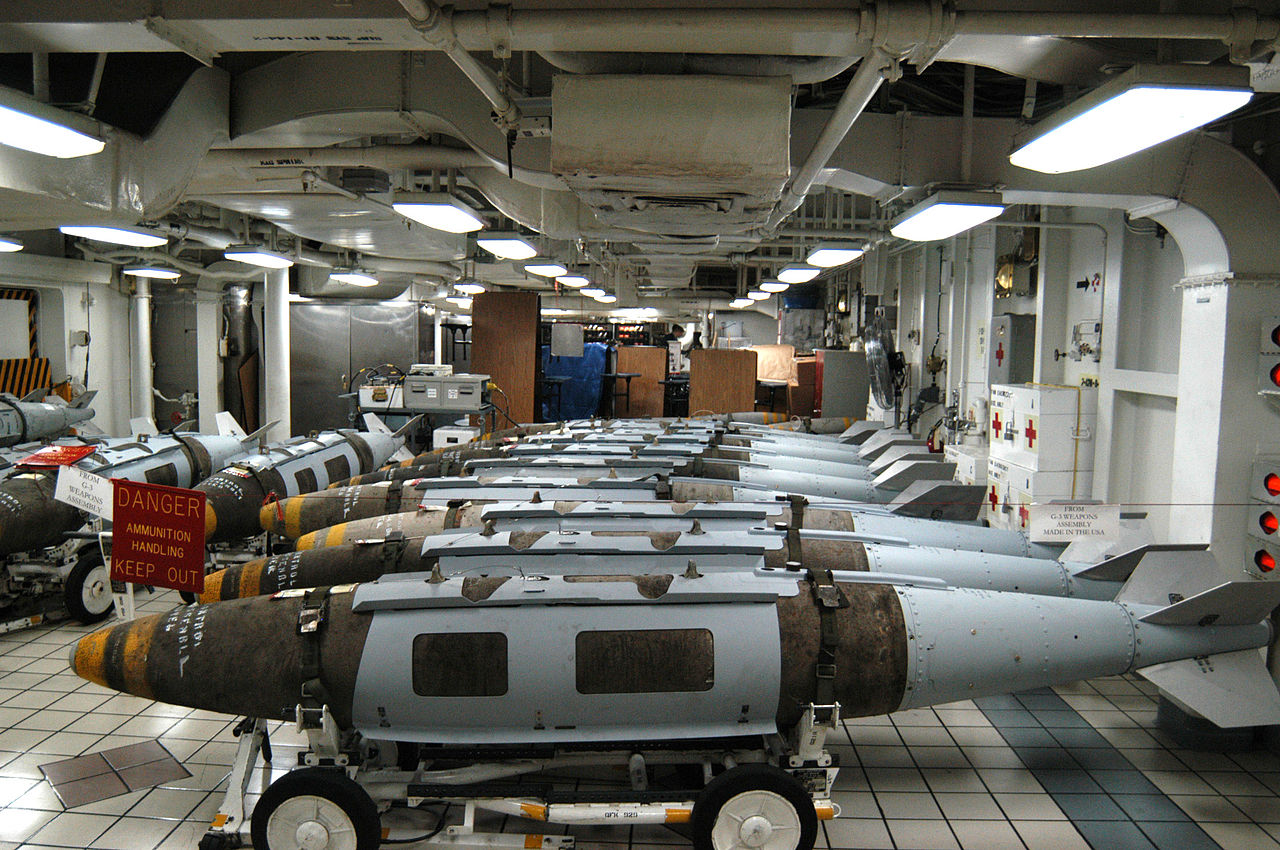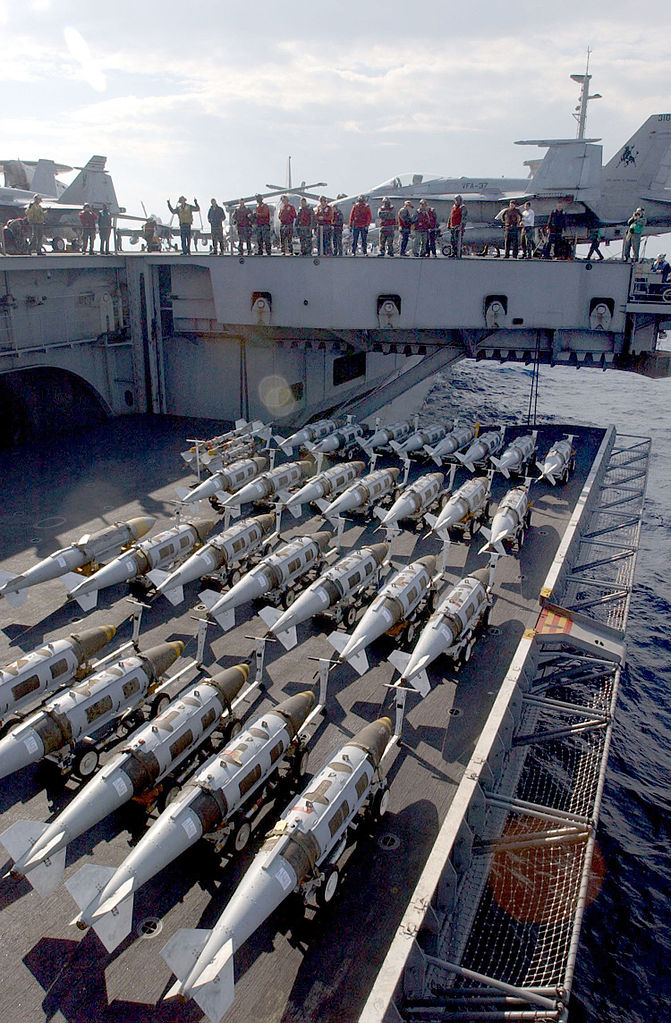The Joint Direct Attack Munition (JDAM) is one of the great military procurement success stories of recent decades. Development began in the aftermath of the Gulf War, with the intent of producing a weapon capable of attacking precision targets in all weather. This would be enabled by GPS, which had just come through its first combat outing with flying colors, allowing the forces that liberated Kuwait to navigate in the trackless desert. It could also, in theory, allow a bomb to hit any target that the operator had coordinates for.

JDAMs are staged on the mess deck of the USS Abraham Lincoln during the invasion of Iraq
The basic concept was the same as the one behind Paveway. Take a standard iron bomb and fit it with new fins and a guidance kit that turn it from something that will hit the ground into something that will hit the target. This greatly simplified the task of the designers, who didn’t have to worry about a warhead, as well as aiding operators who could take advantage of the wide variety of bombs already in the US inventory.
The new guidance method had a number of benefits. The biggest is that the GPS radio signals could penetrate rain, snow, clouds and fog that would block a laser, giving an all-weather precision strike capability. There was also no need for a laser designator, which made the bomb a “fire-and-forget” weapon. After release, the pilot would be free to evade instead of worrying about keeping his laser designator on the target. This also meant that there were no practical limits on the number of bombs that could be in the air at one time, a major change from Paveway.1 During a 2003 test, a B-2 launched 80 JDAMs in a single 22-second pass, all of which hit their individual targets. The new bomb also had a substantial glide capability, similar to Paveway III.

GBU-38s are brought up an ordnance elevator
However, the change in guidance systems wasn’t without drawbacks. First, while GPS can’t be blocked by the weather, it can be interfered with by jamming. To compensate, an inertial navigation system (INS) was fitted. This used basic physics to measure the acceleration the bomb had undergone and use that data to estimate where it was. It wasn’t as accurate as GPS, with a specified CEP2 of 100’ as opposed to 30’ in GPS-guided mode, but it should be enough for most targets. Second, you need actual coordinates for the target, instead of just pointing the laser at it. This is solvable with a laser rangefinder and some fancy electronics, provided the target isn’t moving. If the target is moving, then GPS guidance isn’t the best option.

Some of the JDAM family. L-R: GBU-31 (Mk 84), GBU-31 (BLU-109), GBU-31 (Mk 83) and GBU-54 (Mk 82 LJDAM)
McDonnell Douglas won the competition for JDAM in 1995, shortly before they were acquired by Boeing. Flight testing began in 1996, and IOC (Initial Operational Capability) was declared on the B-52H in December 1998. This was extraordinarily rapid for a modern weapons system, and the resulting weapon was also extremely well-priced. The first batch of JDAMs cost around $18,000 each,3 half of the original estimate, while the total price in 2019 was around $20,000 for each of the 210 tail kits Boeing produces every day. The 400,000th kit was delivered in May 2019, and each, when mated to a bomb fitted with aerodynamic strakes on the nose or midsection, will turn it into a precision weapon.
Exactly how precise is classified, but Boeing has claimed 95% reliability and a CEP of 1.7m for the latest batch. And it’s a very smart weapon, too. It can talk to the jet it's mounted on and dynamically determine where it can be launched from and still reach the target, a surprisingly large area for a ballistic weapon as the guidance system is capable of finding the most efficient flight path to the target. It can also accommodate more constraints than previous weapons. Need the bomb to fly over the target and then go straight down for maximum penetration? JDAM can do that. Need it to fly in horizontally, because the target is the mouth of a cave? JDAM can do that, too.

GBU-31
JDAM has truly revolutionized strike warfare. Previously, a given target had usually required several aircraft, while JDAM allows planners to think in terms of "targets per sortie" instead of "sorties per target". This revolution has had a large number of impacts, ranging from delaying the start of the Iraq War in 2003 to allow stocks to be rebuilt after Afghanistan to influencing the development of the new Gerald R. Ford class carrier, which is optimized to generate the most possible sorties per day instead of the larger alpha strikes4 of the Nimitz class. It has also decoupled accuracy from the launching platform, allowing aircraft to attack precise targets from high altitude, above the envelope of most air-defense systems, and opening the gates for bombers to provide close air support to troops on the ground.
While GPS guidance is great for the new era of network-centric warfare, JDAM is still not particularly suited for attacking moving targets. To solve this, Boeing developed a laser seeker for JDAM, producing the imaginatively-named Laser JDAM (LJDAM). This restores the moving-target capability that Paveway had, as well as giving better precision if the enemy manages to jam GPS.

JDAM's ride an elevator to Harry S Truman's flight deck, ready for targets in Iraq
Nor is LJDAM the only new variant of JDAM developed in recent years. Boeing has also done work on fitting JDAM with folding wings and turning it into a proper glide bomb. JDAM-ER, as the project is known, has been acquired by Australia and South Korea, and extends the range of the weapon from around 15 nm (depending on launch altitude) to as much as 40 nm, giving a standoff weapon at very low cost. The US military has been slow to buy JDAM-ER, but they have spent money on improved fuzes. One of these is the Hard Target Void Sensing Fuze (HTVSF). Traditionally, penetration bombs were fitted with simple delay fuzes, but if the material the bomb had to pierce was different from what the targeteers expected, the bomb would go off in the wrong place. The HTVSF takes the guesswork out of this by detecting when it has entered a void. It is so sophisticated that it can bet set to go off in the second floor of a five-floor underground bunker, and it’s also reprogrammable in the air in case missions change on the fly.
Another recent addition to JDAM’s capability is the mating of JDAM to the Quickstrike aerial mine. This is a fuze kit for an iron bomb which, when dropped into the ocean, will detect ships passing overhead and go off. JDAM is an important addition to Quickstrike, as it gives minelaying aircraft the ability to drop from high altitude at a substantial standoff and allows the mines to be placed precisely for maximum effectiveness, as well as ease of clearance when the war is over. For reasons that are not entirely clear, the focus seems to be on Quickstrike-ER, a JDAM-ER kit with Quickstrike fuzing, which should also give JDAM-ER capability to platforms it is integrated on.
Nor has this been the end of the exciting developments with JDAM. In recent years, several new seekers have joined the laser system in the toolkit. First, there's Quicksink, a dual-mode radar/IIR seeker attached to a standard GBU-31 that allows it to detect a ship and plunge into the water alongside, detonating underneath for maximum damage.5 Another seeker, fitted to JDAM-ER, has been developed to allow the Ukranians to attack Russian GPS jammers. JDAM technology has also been used in the Navy's HAAWC, a wing kit for the Mk 54 torpedo, allowing the P-8 to engage submarines from altitude. And Boeing is currently working on a powered JDAM variant, which mates the JDAM-ER wing kit for the Mk 82 bomb with a small engine, giving a very cheap cruise missile with 300 miles of range. The future is bright for JDAM, and copycat weapons have begun to spring up in arsenals around the world.

GBU-54 Laser JDAMs are readied for loading on the USS Wasp
While JDAM may be the mainstay of American strike capability today, it's not suitable for all targets. Specifically, it produces a single explosion in a specific location, which is great for point targets, but less useful against a vehicle park or infantry camp. Those targets could be blanketed in JDAMs, but it would be easier and more effective to use lots and lots of even smaller explosives instead. We'll look at the bombs designed to do that next time.
1 Laser designators each have a specific “code” which is set into the bombs they drop, allowing multiple LGBs to be used at the same time. However, the number that can be used at once was still limited by how many designators are available. ⇑
2 Circular Error Probable, the radius where half the bombs will land within ⇑
3 Then-year dollars. ⇑
4 The military term for getting as many planes as possible over the target at once. ⇑
5 Parallels to the interwar [[Main/Weird-British-Anti-Ship-Weapons-of-WWII|B-Bomb come to mind here. ⇑

Comments
How does Paveway IV stack up against LJDAM? Are their histories as GPS with added laser guidance vs laser guided with added GPS evident?
And how have guided bombs changed ground doctrine, now that tanks and bunkers are at risk of being plinked?
Paveway IV is basically just the UK version of LDAM, AIUI. I don't have enough information on it to say anything more. I also have no clue why the Saudis have both. Probably just what the Prince in charge of procurement felt like that week.
What are the roll and sea state limitations on ordnance transfer on a carrier? I get that modern bombs are pretty safe until armed (Forrestal fire not withstanding), so you're most likely just going to dent something, but I still imagine the Navy wouldn't be too keen to have bombs rolling around on the flight or hangar decks when the sea state gets crazy.
That's a good question, and one I don't have an answer to. My guess would be that on a carrier (which is a massive ship, and pretty resistant to being thrown around by the sea) you can probably load bombs in any weather you can actually launch and (more importantly) recover airplanes in. I suspect this isn't true for helicopters based on the escorts, but I don't know for sure.
I suspect no one thinks they can practically get a fighter within 10NM of a Chinese port if the big one kicks off, but 40NM is much more achievable.
I meant relative to JDAM-ER, not relative to default Quickstrike.